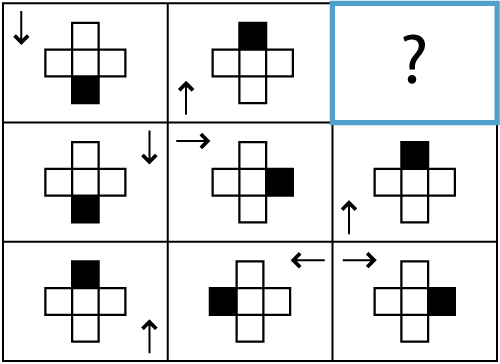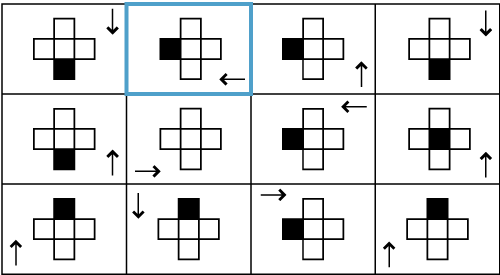Logical Reasoning Analysis and Tips
This guide has been created to help you understand Logical Reasoning tests. Use this analysis to learn how logical reasoning questions work and to find out our advice on tackling these questions.
Page contents:
Jump to:What is logical reasoning?
Logical reasoning tests are designed to measure your powers of logical reasoning and problem solving ability. You will be tested on whether you are able to analyse the images being displayed and to logically deduce the correct answer from the available answer options. One example may be to 'complete the picture' and you must determine which missing piece fits into the missing part of the puzzle.
You will be tested on whether you are able to analyse the images being displayed and to logically deduce the correct answer from the available answer options.
By far the most common form of logical reasoning test is one featuring a grid, with each square in the grid occupied by various shapes of different shadings. Logical reasoning test questions seek to measure a person's pattern-identifying ability.
For a clearer understanding of logical reasoning tests, visit our logical reasoning page where we have a two part logical reasoning video tutorial.
Analysis of a logical reasoning question
Let's go through a logical reasoning question so you can understand the processes involved in tackling such a question.
We are given 9 boxes, each containing an image. They are ordered in rows and columns and form an identifiable patterns. One box, in this case the one in the top right, is unknown. Once we have established a pattern, we can work out the answer and find it as one of the 12 answer options given.

We can first notice that each image seems to have two components. The arrows, with their various directions and positioning in the box, and the cross of squares in the middle of the box, of which one square is always shaded. Let's start with the cross of squares in the top left box. The noticeable feature of these squares is that one is shaded - in this case, the bottom square. The box below has the same square shaded, and the box below that has its top square shaded. The top middle box - top square shaded, middle box - right square shaded, and bottom middle box - left square shaded. While there may be no immediately obvious pattern with the boxes themselves, upon closer inspection, we can see that the arrows are indicating the placement of the shaded squares with their direction. In other words, which direction the arrow points is where the shaded square will be in that box.
However, there's another element we need to consider here. The arrows are moving between the corners of each box. If we start from the top left box and look down the column, we can see that the arrow moves from: top left, top right to bottom right. In other words, moving clockwise every box going down. If we start from the bottom left box and look across the row, we can see that the arrow moves from: bottom right, top right to top left - moving anti-clockwise every box going right. These patterns should now allow us to discover our answer.
Going from left to right, or bottom to top, our arrow should be placed in the bottom right corner. Given that the direction of the arrows and shaded squares appear to not have a pattern, all we need from them is that they are both going in the same direction. Now let's look at our answer options.

We can see only 4 boxes have the arrow in the bottom right corner, and only one of them adheres to same direction pattern - the box highlighted with a blue border.
Our logical reasoning tips
Now that we've analysed an example question, it's time to learn some of our tips specifically tailored to logical reasoning tests.
You can watch our video below where Ben talks through some logical reasoning tips, and also read through the tips below:

Start with the easiest pattern
In most logical reasoning questions, there will be multiple logical variables going on in order to determine the correct answer. But not all variables are equal in their complexity.
Use your intuition or perhaps just by glancing at the series of images will you be able to determine which pattern is the most straightforward. This might be something like a box changing shade, an arrow changing direction. If you can work out that pattern, you might narrow down the answer options considerably early on, making it much easier to figure out the correct answer.
If fact, if you’re really lucky, there’ll only be one answer fitting your easy pattern and you’ll get the correct answer without having to figure out any of the other patterns – but be careful with that.
Check the Pattern Works Forwards and Backwards
Sometimes the best way to test whether your logic is consistent is to check the pattern works backwards as well as forwards, like in this example. Of course, this will not always be relevant, but most of the time looking at it backwards will just mean the pattern in reverse and if it works in reverse it will help reveal that your pattern works logically.
Be Aware of Time
It’s important that you don't spend a lot of time answering each question, particularly if you feel that time could be better spent on other questions, so it’s imperative you find ways to be faster.
Once you gain more confidence you might find that you won’t need to triple or quadruple check every pattern in every question which will help save you time. So in a way, confidence will help save you time.
Lots of practice
Practice doesn’t just involve taking 10 tests then deciding you’re ready - it involves a learning process. You must look at your test performance - review the questions you answered incorrectly and read the explanations on why your answer wasn't correct and how the true correct answer could have been obtained.
Logical reasoning tips
We firstly recommend you do watch our logical reasoning tutorial, mentioned above, if you haven't already as this will help you understand the question types. But for now, let's move onto the tips.
Familiarity is key
Logical reasoning tests can look very complex at first glance. There's a series of odd looking shapes that are in unfamiliar sequences and you're expected to understand what comes next within several seconds - it's not easy! Becoming familiar with understanding patterns of symbols and shapes will result in less time wasted trying to understand what's going on. This will give you a competitive advantage over those candidates that are not utilising practice tests.
Have a system
It's important to enter a question with a game-plan which you can initiate immediately. Try not to tackle all the different symbols and shapes as a collective but separate them into individual symbols. Notice how certain shapes are changing through the sequence and build up the missing sequence from individual component parts.
Your system should also consider time. Work out how much time you are allowed per question and practise completing questions within those time constraints.
Don't spend your first moments looking at the answers
It's common to look at the answer options after your first look at the question but this can be wasteful. Your time is precious in a test and initial looks at the answer options will not help you to understand the sequence and could distract you. Focus on the question and the sequence then once you have a general idea of what the missing image could be, you could check the answer options to eliminate some of the options.
Practise thinking logically
The more able you are to think logically the easier you will find these test types. As well as practice tests you can try other brain teasers like sudoku, crosswords, and those types of challenges which will train your brain to be more familiar with the required skills.
Practice makes perfect
Practising these tests will help you refine your system and make you confident answering these questions. You will be able to understand any potential weaknesses you have and allow you to work on them.
Now it's time to practise
We have taken a look at a logical reasoning question, and analysed the way that the logical reasoning logic works. Now let's put into practice by taking some free logical reasoning tests, designed to emulate the real thing. Simply sign up to our free starter account below to access the tests, completely free of charge.
Start practising quality tests with a free account
Practice makes perfect
- Learn from detailed solutions
- Track your progress

Additional psychometric test resources
We have lots of specialised and specific psychometric test advice waiting for you. Simply navigate over to our resources section where you can find all of our test advice, or click on one of the following links you may find useful:
